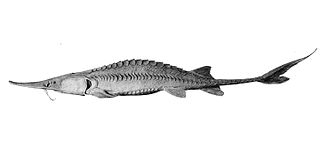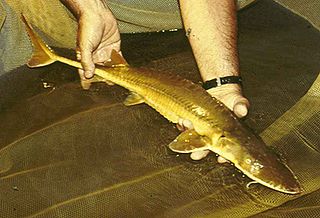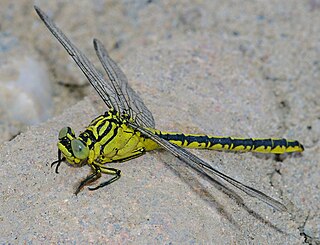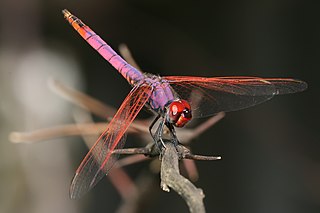
Sturgeon is the common name for the 28 species of fish belonging to the family Acipenseridae. The earliest sturgeon fossils date to the Late Cretaceous, and are descended from other, earlier acipenseriform fish, which date back to the Early Jurassic period, some 174 to 201 million years ago. They are one of two living families of the Acipenseriformes alongside paddlefish (Polyodontidae). The family is grouped into four genera: Acipenser, Huso, Scaphirhynchus, and Pseudoscaphirhynchus. Two species may be extinct in the wild, and one may be entirely extinct. Sturgeons are native to subtropical, temperate and sub-Arctic rivers, lakes and coastlines of Eurasia and North America.

Megalagrion is a genus of damselflies in the family Coenagrionidae. It contains approximately 26 species, all of which are endemic to Hawaiʻi. Megalagrion damselflies are the only native damselflies in Hawaiʻi, and are referred to as "pinapinao" in ʻʻŌlelo Hawaiʻi. Other native Hawaiian dragonfly species include Anax strenuus and Nesogonia Blackburni, which are referred to as "pinao".

Leptotyphlops is a genus of nonvenomous blind snakes, commonly known as slender blind snakes and threadsnakes, in the family Leptotyphlopidae. The genus is endemic to and found throughout Africa. Eleven species have been moved to the genus Trilepida, and other species have been moved to the genera Epacrophis, Epictia, Mitophis, Myriopholis, Namibiana, Rena, Siagonodon, Tetracheilostoma, and Tricheilostoma.

The shovelnose sturgeon is the smallest species of freshwater sturgeon native to North America. It is often called hackleback, sand sturgeon, or switchtail. Switchtail refers to the long filament found on the upper lobe of the caudal fin. Shovelnose sturgeon are the most abundant sturgeon found in the Missouri River and Mississippi River systems, and were formerly a commercially fished sturgeon in the United States of America. In 2010, they were listed as threatened under the U.S. Endangered Species Act due to their resemblance to the endangered pallid sturgeon, with which shovelnose sturgeon are sympatric.

The pallid sturgeon is an endangered species of ray-finned fish, endemic to the waters of the Missouri and lower Mississippi river basins of the United States. It may have even reached the St. Croix River before colonization.

The Alabama sturgeon is a species of sturgeon native to the United States of America and now only believed to exist in 130 miles (210 km) of the lower Alabama River. The fish has a distinctive yellowish-orange color, grows to a size of about 30 in (76 cm) long and 2 to 3 lb (0.9–1.4 kg), and is believed to have a lifespan of 12 to 20 years. Biologists have known of the fish since the 1950s or 1960s, but the large diversity of aquatic species in Alabama prevented formal identification until 1991.

The Sakhalin sturgeon is a species of fish in the family Acipenseridae. It is found in Japan and Russia.

Pseudoscaphirhynchus is a genus of relatively small, highly threatened sturgeons that are restricted to the Aral Sea system, including the Amu Darya and Syr Darya river basins, in Central Asia.

Paragomphus is a genus of dragonfly in the family Gomphidae. They are commonly known as Hooktails.

Platycypha is a genus of African damselflies in the jewel damselfly family (Chlorocyphidae).

Stylurus is a genus of dragonflies in the family Gomphidae. They are commonly known as Hanging Clubtails from their habit of hanging nearly vertically when they perch.

Trithemis is a genus of dragonflies in the family Libellulidae. They are commonly known as dropwings. There are over 40 species, mainly from Africa; two are endemic to Madagascar, and five can be found in Asia. They are found in a wide variety of habitats; some species being adapted to permanent streams in forests, and others being capable of breeding in temporary pools in deserts.
The rocky shiner is a species of ray-finned fish in the genus Notropis. It is endemic to the United States where the species is known from tributaries of the Red River draining the Ouachita Mountains in southeastern Oklahoma and southwestern Arkansas, including several localities in the Kiamichi, Little and Muddy Boggy rivers. Its range extends west to the Blue River in Oklahoma, and east to the Cossatot River in Arkansas.

Orthemis is a genus of large Neotropical dragonflies, commonly called Tropical King Skimmers. The males are generally red and the females brown.
Opsarius is a genus of fish. Its representatives can be found in a variety of countries in South East Asia. These countries include Cambodia, Laos, Thailand, Myanmar, India, and China. Certain species of Opsarius are considered endemic to their respective habitats; such as Opsarius cocsa and Opsariusmaculatus which are endemic to India.














